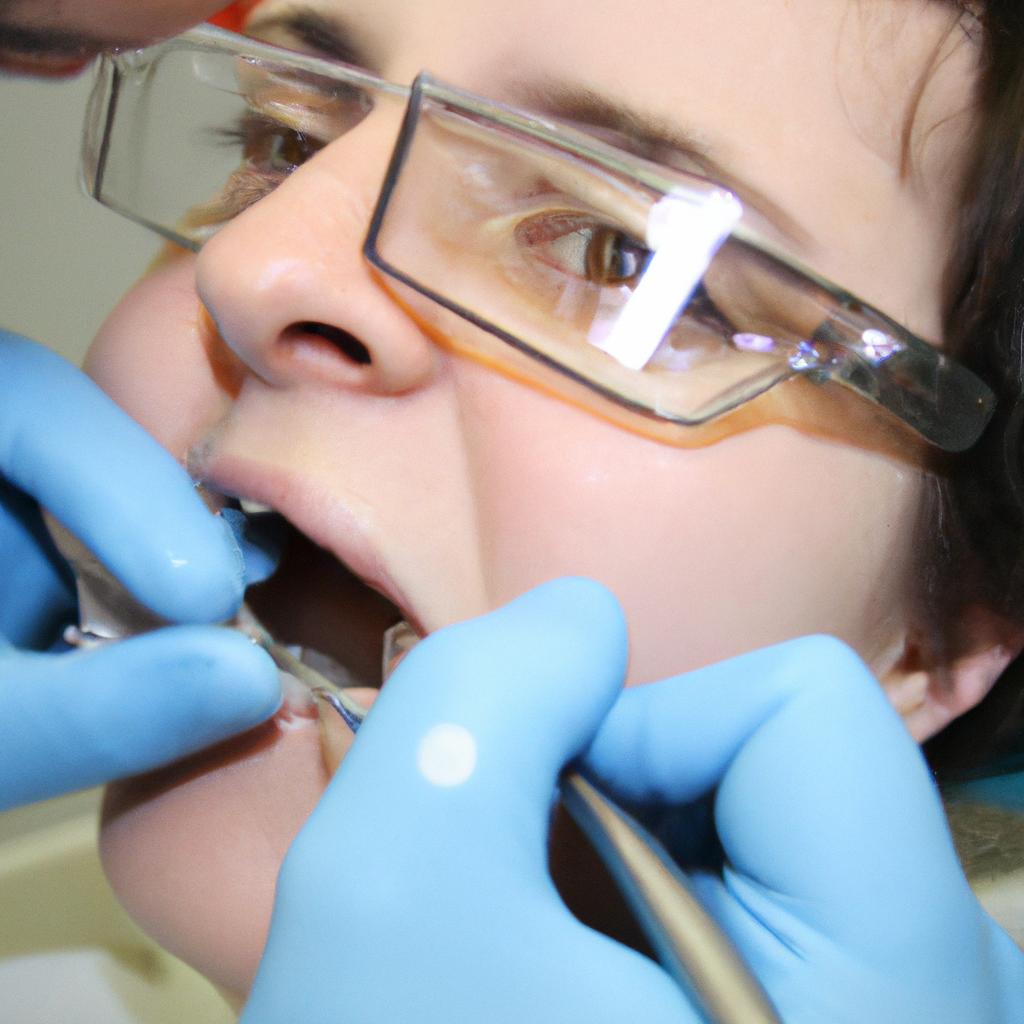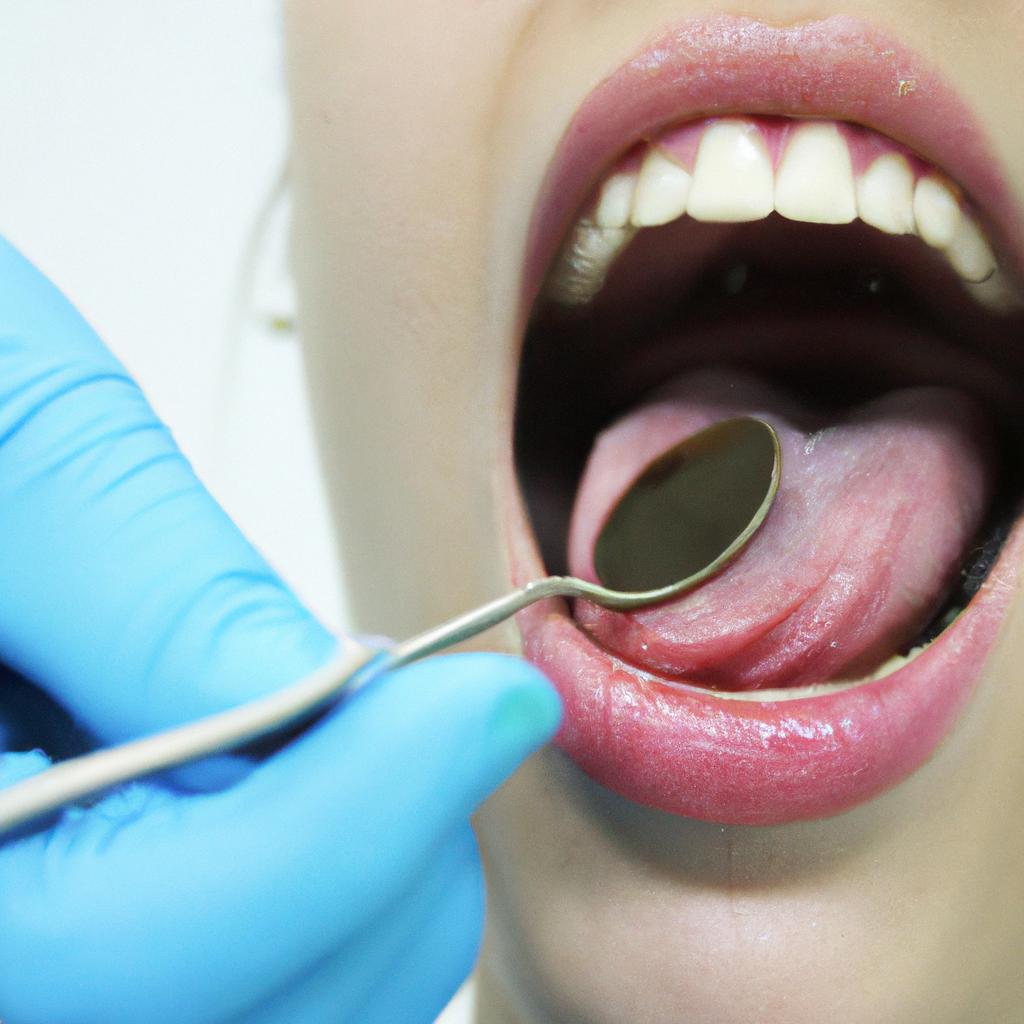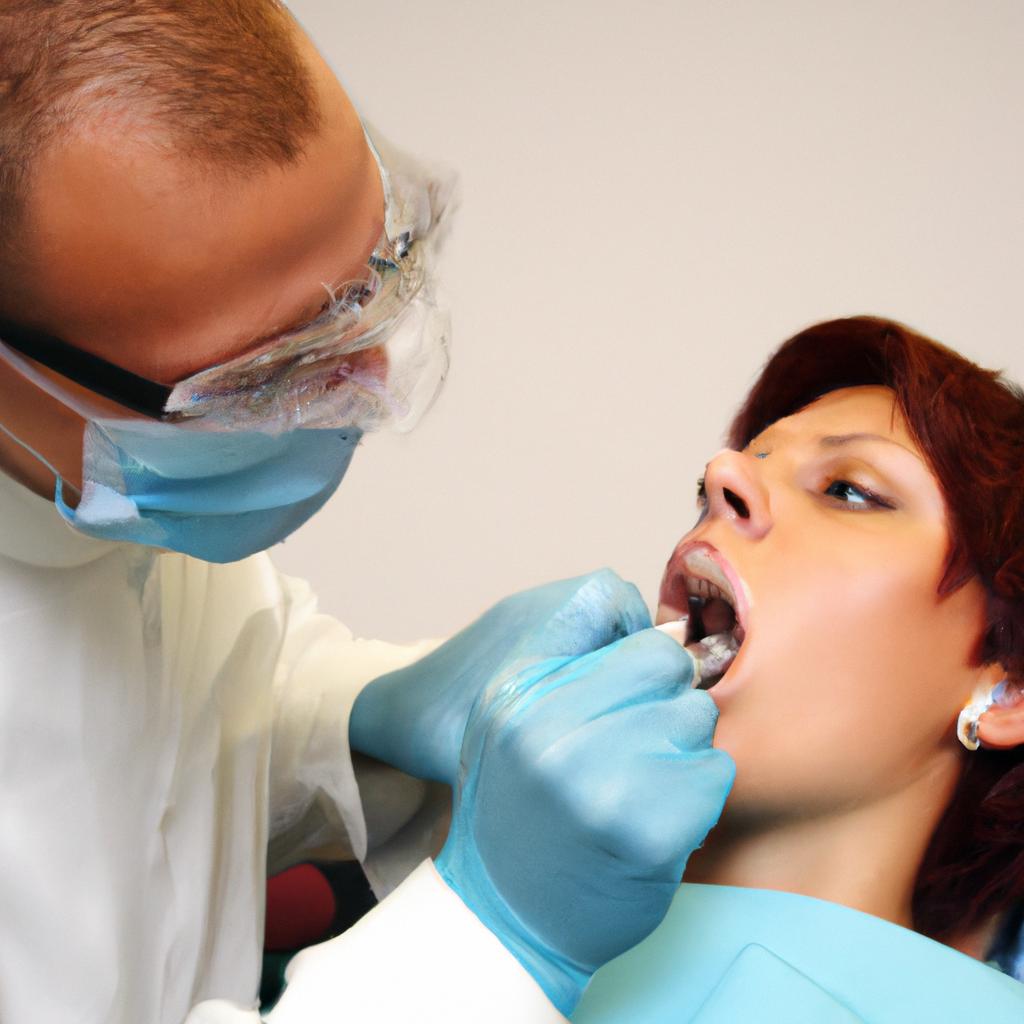Gum Grafting in Periodontics: A Comprehensive Guide

Gum grafting is a surgical procedure commonly performed in the field of periodontics to address various gum-related issues. It involves the transplantation of healthy gum tissue from one area of the mouth to another, with the aim of restoring and enhancing both functional and aesthetic aspects of the gums. For instance, consider a hypothetical case where an individual has suffered from severe gum recession due to aggressive brushing habits. This condition not only poses risks for tooth sensitivity and root exposure but also affects the overall appearance of their smile. In such cases, gum grafting can provide an effective solution by replenishing lost tissue and promoting long-term oral health.
The primary objective of this comprehensive guide is to shed light on the various aspects related to gum grafting in periodontics. Through an academic lens devoid of personal pronouns, this article will explore different types of grafts used in practice, including autografts, allografts, and xenografts, as well as discuss their indications and contraindications. Furthermore, it will delve into pre-operative evaluations that help determine patient suitability for the procedure, highlighting factors such as medical history and oral hygiene status. Additionally, post-operative care measures necessary for successful healing and recovery will be elucidated along with potential complications and their management. The guide will also touch upon alternative treatment options for gum recession, such as non-surgical techniques like scaling and root planing or the use of regenerative materials.
Throughout the article, relevant case studies and clinical examples will be provided to illustrate the application of gum grafting in real-life scenarios. Furthermore, evidence-based research findings and current best practices in the field will be included to ensure that the information presented is up-to-date and reliable.
By the end of this comprehensive guide on gum grafting in periodontics, readers will have a thorough understanding of the procedure, its benefits, potential risks, and considerations for patient selection. Armed with this knowledge, dental professionals can make informed decisions regarding treatment planning and provide optimal care to patients seeking gum restoration or aesthetic improvement.
What is Gum Grafting?
What is Gum Grafting?
Imagine a patient, Sarah, who has been experiencing gum recession due to periodontal disease. Her gums have receded to the point where her tooth roots are exposed, causing sensitivity and aesthetic concerns. In cases like this, gum grafting can be an effective treatment option. Gum grafting is a surgical procedure performed in periodontics that involves taking tissue from one area of the mouth (usually the palate) and transplanting it onto areas of gum recession.
Gum grafting serves several important purposes in restoring oral health:
- Protection: One key benefit of gum grafting is providing protection for exposed tooth roots. When gums recede, the root surfaces become vulnerable to decay, abrasion, and other forms of damage. By covering these surfaces with grafted tissue, gum grafting helps shield them from harm.
- Aesthetic Improvement: Another significant advantage of gum grafting is its ability to enhance the appearance of the smile. Receding gums can give teeth an elongated or uneven look, which may impact self-esteem and confidence levels. The use of grafted tissue allows for a more balanced and aesthetically pleasing gumline.
- Sensitivity Reduction: Exposed tooth roots often lead to heightened sensitivity to hot or cold temperatures and certain foods or drinks. Gum grafting can alleviate this discomfort by creating a protective barrier over the sensitive areas.
- Stabilization: Gum recession compromises the support system for teeth since healthy gums play a crucial role in holding them firmly in place. Through gum grafting, stability can be restored by strengthening weakened gums.
To better understand how gum grafting works, consider Table 1 below:
| Types of Gum Grafts | Description | Advantages | Disadvantages |
|---|---|---|---|
| Connective Tissue | Most common type; involves harvesting connective tissue from the palate and stitching it to the recipient site | Excellent long-term results; effective for covering multiple exposed tooth roots | Requires two surgical sites |
| Free Gingival | Involves a similar process as connective tissue grafting but uses only epithelial tissue instead of connective tissue | Suitable for patients with thin gums; helps increase gum thickness | Less predictable root coverage compared to other methods |
| Pedicle | Uses nearby gum tissue adjacent to the recession area, preserving its connection to the blood supply | No need for additional donor site; less invasive procedure | Limited application due to specific anatomical requirements |
| Allograft | Utilizes donated human tissue rather than harvesting from the patient’s own mouth | No secondary surgical site required; eliminates potential complications associated with palatal harvesting | Slightly higher risk of immune response or disease transmission |
In summary, gum grafting is a surgical technique used in periodontics to address gum recession. By protecting teeth roots, improving aesthetics, reducing sensitivity, and enhancing stability, this procedure offers numerous benefits for patients like Sarah.
Transition: Now that we have discussed what gum grafting entails, let us delve into the various types available.
Types of Gum Grafts
Understanding the importance of gum grafting in periodontics, let us now delve into the different types of gum grafts that are commonly used to address gingival recession.
To illustrate the efficacy and versatility of gum grafting, consider a hypothetical case study where a patient presents with severe gingival recession on their lower anterior teeth. In this scenario, the dentist recommends performing a connective tissue graft, one of the most widely employed techniques for treating such cases.
Connective Tissue Graft:
- Autograft: The patient’s own subepithelial connective tissue is harvested from another area within the oral cavity, typically the palate. This technique provides an excellent source of viable cells and collagen fibers.
- Allograft: Utilizing donated human tissue offers an alternative to autogenous grafts. Allograft materials undergo rigorous processing to ensure biocompatibility and minimize immunogenicity.
- Xenograft: Derived from animal sources, xenografts provide structural support while promoting new tissue growth through guided regeneration mechanisms.
- Synthetic Materials: Innovations in biomaterial science have led to synthetic options that mimic natural tissues’ properties and promote host integration.
Gum grafting can help improve oral health by:
- Restoring lost gum tissue
- Reducing tooth sensitivity caused by exposed root surfaces
- Enhancing aesthetic appearance
- Preventing further progression of gingival recession
| Types of Gum Grafts | Characteristics | Advantages | Disadvantages |
|---|---|---|---|
| Connective Tissue | Harvested from either patient or donor source | Provides predictable outcomes | Additional surgical site required |
| Free Gingival | Obtained directly from the palate | Suitable for patients with thin gums | Limited availability due to small size |
| Pedicle | Adjacent gum tissue is rotated to cover recession | Utilizes existing tissue for grafting | Restricted to specific anatomical locations |
| Alloderm | Human donor tissue | No secondary surgical site required | Higher cost compared to other techniques |
In light of the various types of gum grafts available, it is evident that periodontists have a range of options when addressing gingival recession. By carefully considering factors such as patient suitability, esthetic goals, and clinical requirements, practitioners can choose the most appropriate technique for each case.
Understanding the different types of gum grafts provides a foundation for exploring the causes and symptoms of gingival recession.
Causes and Symptoms of Gingival Recession
Now, let us delve into the causes and symptoms associated with this condition.
Gingival recession occurs when the gum tissue surrounding the teeth wears away or pulls back, exposing more tooth surface or even root surfaces. This can lead to increased sensitivity, aesthetic concerns, and potential oral health issues if left untreated. One illustrative hypothetical case involves a patient named Sarah who noticed her gums receding gradually over time due to aggressive brushing habits and inadequate oral hygiene practices.
Causes of Gingival Recession:
- Periodontal Disease: When gum disease is present, it can cause inflammation and damage to the supporting structures around the teeth, leading to gum recession.
- Aggressive Brushing Techniques: Excessive force while brushing or using a hard-bristled toothbrush can contribute to gum tissue abrasion and recession.
- Genetics: Some individuals may be genetically predisposed to having thinner or weaker gum tissues that are more prone to recession.
- Hormonal Changes: Fluctuations in hormone levels during puberty, pregnancy, or menopause can make gums more susceptible to recession.
Symptoms of Gingival Recession:
- Tooth Sensitivity: Exposed roots lack the protective enamel covering, making them sensitive to hot or cold temperatures.
- Longer-Looking Teeth: As the gum line recedes further down the tooth surface, teeth may appear longer than usual.
- Visible Root Surface: In advanced cases of recession, patients might notice exposed root surfaces.
- Redness and Swelling: The affected area may exhibit signs of inflammation such as redness and swelling.
To better understand these causes and symptoms visually:
| Causes | |
|---|---|
| Periodontal Disease | 🌡️ |
| Aggressive Brushing Techniques | 🖐️ |
| Genetics | 👩👧👦 |
| Hormonal Changes | 💊 |
The emotional impact of gingival recession should not be underestimated. Patients like Sarah may experience feelings of self-consciousness, discomfort, and worry about the long-term consequences on their oral health. However, by identifying the causes and recognizing the symptoms early on, individuals can take proactive steps towards seeking appropriate treatment.
In preparation for gum grafting surgery, understanding the procedure’s various aspects is crucial.
Preparation for Gum Grafting Surgery
Having discussed the causes and symptoms of gingival recession, it is crucial to understand how one should prepare for gum grafting surgery. To illustrate the significance of this preparation, let us consider a hypothetical case study. Sarah, a 40-year-old patient with severe gum recession caused by aggressive tooth brushing habits, has decided to undergo gum grafting surgery to restore her oral health and aesthetics.
Before undergoing gum grafting surgery, patients need to take certain steps to ensure optimal outcomes. These preparations involve both physical and psychological aspects. Here are some key considerations:
-
Oral Hygiene:
- Maintain regular oral hygiene practices such as brushing and flossing.
- Use a soft-bristled toothbrush and avoid aggressive brushing techniques.
- Incorporate an antimicrobial mouthwash into daily oral care routine.
-
Medical Evaluation:
- Undergo a thorough medical evaluation before the procedure.
- Inform your periodontist about any pre-existing medical conditions or medications you may be taking.
-
Lifestyle Adjustments:
- Avoid smoking or using tobacco products as they can hinder the healing process.
- Adopt a healthy diet rich in vitamins and minerals that promote tissue regeneration.
-
Emotional Support:
Markdown list- Seek emotional support from family and friends during the preparation phase.
- Engage in stress-reducing activities like yoga or meditation.
- Communicate openly with your healthcare provider regarding any anxieties or concerns.
To further emphasize the importance of these preparatory measures, consider the following table showcasing potential benefits associated with adequate preparation:
| Preparation Measure | Benefits |
|---|---|
| Maintaining good oral hygiene | Reduced risk of infection |
| Undergoing medical evaluation | Identification of underlying health issues |
| Making lifestyle adjustments | Enhanced overall well-being |
| Seeking emotional support | Increased psychological resilience and improved coping mechanisms |
By diligently following these preparatory steps, patients like Sarah can significantly enhance the success of their gum grafting surgery. The next section will delve into the details of the gum grafting procedure itself, providing a comprehensive understanding of this vital periodontal treatment.
With adequate preparation in mind, let us now explore the Gum Grafting Procedure and its various stages.
Gum Grafting Procedure
Once the patient has completed the necessary preparations for gum grafting surgery, it is essential to understand the various steps involved in the actual procedure. By following a structured approach, periodontists can achieve optimal outcomes and restore healthy gingival tissues. Let us now delve into the details of the gum grafting procedure.
Paragraph 1:
To illustrate this process, consider a hypothetical case study involving a patient named Sarah. Sarah presents with severe gum recession in her lower front teeth due to aggressive tooth brushing habits. After careful evaluation by her periodontist, it is determined that she would benefit from a connective tissue graft to restore her receded gums. The procedure involves three main stages: anesthesia administration, graft harvesting or preparation, and graft placement.
Paragraph 2:
During anesthesia administration, local anesthetic is injected near the treatment area to ensure Sarah’s comfort throughout the procedure. Once adequate numbness is achieved, the periodontist proceeds with graft harvesting or preparation. In this step, a small incision is made at the donor site (often from the roof of Sarah’s mouth) to obtain connective tissue that will serve as the graft material. Meanwhile, another small incision is created at the recipient site (where recessed gums require repair). This allows access for placing and securing the graft.
-
Important considerations during gum grafting surgery include:
- Selecting appropriate suture materials
- Ensuring proper flap design and tension-free closure
- Maintaining meticulous hemostasis
- Providing post-operative instructions for optimal healing
The table below summarizes these crucial factors:
| Considerations | Description |
|---|---|
| Suture Materials | Use non-absorbable sutures such as silk or polytetrafluoroethylene (PTFE) |
| Flap Design and Closure | Carefully plan the incisions and secure graft placement |
| Hemostasis | Control bleeding during the procedure |
| Post-Operative Instructions | Provide guidelines for optimal healing |
Paragraph 3:
Once the connective tissue graft is properly positioned, it is secured in place using sutures. Sarah’s periodontist ensures that the graft achieves proper vascularization by carefully adapting it to the recipient site. After completing the gum grafting procedure, Sarah will be given detailed instructions on post-operative care and hygiene maintenance.
With the completion of the gum grafting procedure, attention turns towards recovery and aftercare measures. It is crucial for patients like Sarah to understand how they can aid their own healing process while minimizing complications. Let us now explore some essential aspects related to recovery and aftercare following gum grafting surgery.
Recovery and Aftercare
Gum grafting is a surgical procedure commonly performed in periodontics to restore gum tissue lost due to factors such as gum recession or trauma. This section provides an overview of the recovery and aftercare process following a gum grafting procedure. Understanding how to properly care for your gums post-surgery is crucial for optimal healing and long-term success.
Once the gum grafting procedure is complete, it is important to follow specific instructions provided by your periodontist. These instructions may include recommendations on pain management, diet restrictions, oral hygiene practices, and follow-up appointments. Compliance with these guidelines will help ensure that the newly grafted tissue heals properly and minimizes complications.
To promote effective recovery, here are some key points to keep in mind:
- Pain Management: Discomfort after surgery can be managed with prescribed pain medication or over-the-counter analgesics recommended by your periodontist.
- Diet Restrictions: For the first few days following a gum grafting procedure, sticking to soft foods that require minimal chewing is advisable. Examples include yogurt, mashed potatoes, soup, and scrambled eggs.
- Oral Hygiene: Maintaining good oral hygiene is essential during the recovery period but should be done gently to avoid disturbing the sutures or causing damage to the grafted area. Rinsing with saltwater solution or antibacterial mouthwash can aid in keeping the area clean.
- Follow-Up Appointments: Regularly scheduled follow-up visits allow your periodontist to monitor the progress of healing and make any necessary adjustments to ensure successful outcomes.
It is worth noting that individual experiences may vary depending on factors such as overall health status and adherence to post-operative care instructions. To provide further insight into expected outcomes and potential risks associated with gum grafting procedures, refer to Table 1 below:
| Potential Outcomes | Possible Complications | Expected Duration |
|---|---|---|
| Successful tissue | Infection | Initial healing: 1-2 |
| integration | Bleeding | weeks |
| Improved aesthetics | Swelling | Complete healing: |
| Discomfort | 6-8 weeks |
Table 1: Common outcomes, potential complications, and expected duration of gum grafting recovery.
In summary, proper post-operative care is crucial for the successful recovery following a gum grafting procedure. By adhering to prescribed guidelines from your periodontist and taking necessary precautions, you can optimize healing and achieve long-term benefits. Remember to attend scheduled follow-up appointments to ensure that any concerns are promptly addressed by your oral healthcare provider.





